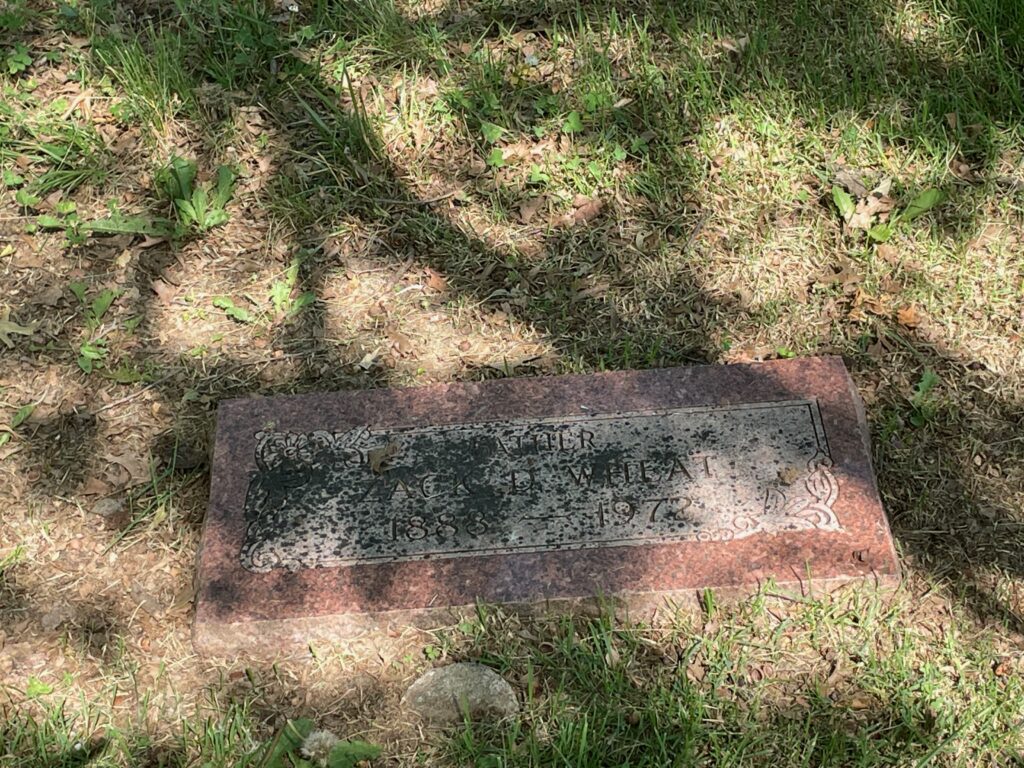Erik Visits an American Grave, Part 1,404
This is the grave of Zack Wheat.

Born in 1888 in Hamilton, Missouri, Wheat has an evidently unexceptional childhood, except for being very good at baseball. In 1906, he got a contract to play for Enterprise in the Kansas League. This led to a rise through the minors and his purchase by the Brooklyn Superbas late in 1909 season. As an aside, the Dodgers is not a bad name by any means, but I really think Congress should pass a law demanding that the team return to the Superbas. It would just make everything better.
Now, this was the deadball era. Wheat didn’t have any power either. But he did hit differently. Basically he hit a lot more like a modern batter. A lot of those deadball guys, just looking to make any kind of contact, shortened the bat from the beginning by choking up all the time. Wheat didn’t do that. Even as a 22 year old rookie in 1910, Wheat was pretty good, hitting .284/341/403 and playing an effective left field. That .284 led the Superbas (the last year they used that name). But that would be the second lowest batting average of Wheat’s career, one that oddly saw him get better and better well into his 30s. He had good power for the era; in his second year, he hit 11 triples and 5 homers, which, yes, was good power. Usually hitting between 5 and 9 home runs over the next several years, Wheat would consistently rank in the top 10 in the majors. In 1916, he hit 9 taters. That helped him lead the National League with a .461 slugging percentage. It was a different game, that’s for sure! As of right now, that slugging would tie Wheat with Austin Hays for 45th in major league baseball in 2023. Though before you laugh, my pickup of Hays has led me to first place in the LGM and Friends fantasy league (Farley is last of course).
Interestingly, for being basically one of the great hitters of his time, the only other time Wheat led the league in any important category was in 1918, when he led with a .335 batting average. But he was just always good. And he got better and better. As the deadball era slipped away in the early 20s, he upped his power toward 15 homers a year. Moreover, his batting average continued to rise too. In his age 35 and 36 seasons–1923 and 1924–he hit .375 consecutively. That’s really impressive. In 1924, he finished third in MVP voting. According to Baseball Reference’s WAR stat, this was Wheat’s best season, with 6.8 WAR. That’s not quite a great player there, since most of his seasons were more in the 2 to 4 WAR range, but there were just so many of them and he was always so good that he still ranks as one of the best left fielders to ever play the game.
Wheat also had a unique way of getting more money for himself from those cheap owners who tried to pay players the way they paid coal miners and steel workers–nothing. In 1912, he married and his wife was very sharp on these issues. After that, Wheat kept holding out every year and forcing the Dodgers to increase his contract. This got pretty inventive. When the U.S. entered the war in 1917, Wheat took advantage. He started raising pack animals and sold them to the military. Before the 1918 season, he simply said he didn’t need to play at all, as he was making so much money from the Army that why would he bother? This forced the Dodgers to cave to all his demands immediately.
Wheat really only started declining in 1926. He slipped a bit that year, not much, but the Dodgers moved him to the As at the end of the year. He was reasonably effective in 1927, but he was old and injuries were making it hard to keep going. The As decided to move on. Wheat was determined to continue. He played 1928 for Minneapolis in the American Association, but his body said no and he missed most of the season with a heel injury. He retired at the end of the season.
In retirement, Wheat had to work. He had a farm (where he had raised the mules), but he lost in the Great Depression. He moved to Kansas City and ran a bowling alley for awhile. Then he became a cop. He almost died during a high speed pursuit in 1936 when he crashed the car. He was in the hospital for five months recovering. He left the force after that and opened a hunting resort on the Lake of the Ozarks.
Wheat was elected to the Hall of Fame in 1959, his first year of eligibility, by the Veterans Committee. According to the rules of the time, you had to be retired 30 years for Veterans Committee eligibility. In fact, they tried to get him in 1957, but the HOF vetoed it for only being 28 years. Wheat died of a heart attack in 1972, at the age of 83.
Zack Wheat is buried in Forest Hill Cemetery, Kansas City, Missouri.
If you would like this series to visit other left fielders, you can donate to cover the required expenses here. According to Baseball Reference’s JAWS stas, Wheat is the 16th best left fielder of all time. We’ve already covered Willie Stargell at #15. Sherry Magee, who at #14 is the top left fielder other than those tainted or banned (Bonds, Rose, Manny) not in the Hall of Fame, is in Drexel Hill, Pennsylvania and Joe Medwick at #17 is in Sunset Hills, Missouri. Previous posts in this series are archived here and here.


